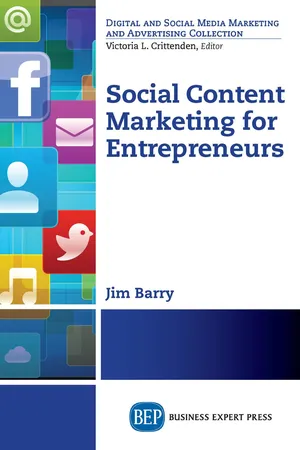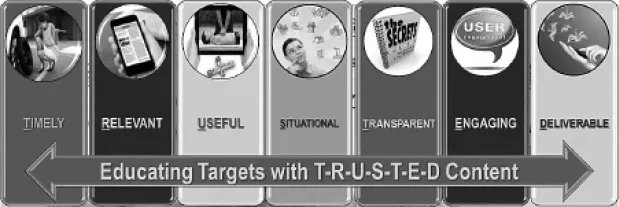![]()
PART 1
Getting Audiences to T-A-L-K
A good first step in any social content-marketing plan is to lay out the elements required to get your target audiences to T-A-L-K. In the next three chapters, we will find out how social media gets your potential prospects to
1. Trust you (Chapter 1)
2. Align with you (Chapter 2)
3. Like you (Chapter 3)
4. Know you (Chapter 1).
Summary Model of Factors Getting Audiences to T-A-L-K
![]()
CHAPTER 1
Educating Targets with T-R-U-S-T-E-D Content
Traditional marketing talks at people. Content marketing talks with them.
—Doug Kessler, Cofounder of Velocity
Did you ever imagine a world without cold calling or interrupting ads? How about one where marketers share their secrets for free? There go all of our textbooks on baiting audience attention and holding them hostage to switching costs and the remorse of lost opportunities.
But in the immortal words of Charles Dickens, these are “the best of times and the worst of times.” As quickly as sales personnel and marketing communications departments are departing their professions, brand publishers and entrepreneurs are relishing the opportunity to unseat the big dogs in their industries with content-marketing strategies. Instead of watching deep pocket competitors monopolize billboards, commercials, and print ads, smaller businesses can outflank them in audience exposure and engagement with carefully crafted blogs, webinars, and e-Books that help rather than sell. In essence, they let their content do the talking and only when asked.
The first stage of any social content plan should begin with discovering and qualifying conversational topics that could stir up the passions of your intended audience while inviting you to demonstrate your trust. This trust with a targeted audience is created to a large degree by the content itself. One way to look at this is to consider the evidence backing a society’s migration away from transactional marketing to relationship marketing. The latter is driven primarily by communications, trustworthy actions, expertise, and social bonding. Contrast this with sales offers and promises of great deals often associated with transactional marketing.
Relationship marketing theories posit that trust is the result of benevolent activities—like donating advice without expecting something in return. This implies that new comers to a community must show their willingness to help before promoting any offers. These offers not only suggest opportunism, but they also preempt your opportunities to get invited to communities thriving as much on research advice as on what to buy.
But how can this be done online? Why not start with content that benefits your targeted community through education or by feeding a passion? For example, American Express hosts an advice sharing platform, known as the Open Forum, which provides valuable information to entrepreneurs on running their businesses. Consequently, they have rejuvenated their credit card image as one that helps start-ups and early business growth. In the process, they entered their audience’s sphere of influence.
Once invited to an audience’s sphere of influence, relationship marketing theories suggest that these prospects will subsequently subject you to a series of trustworthiness exercises through ongoing communications and information disclosure. This may include a request for more content or an examination of your willingness to participate in a nonopportunistic manner.
In theory, we could build trails of trustworthy blogs at the top of the sales funnel to encourage deeper engagement with audiences as they advance through their buying journey. These blog posts and other forms of light content at the top of the sales funnel allow audiences to test our expertise and helpfulness before diving into more in-depth webinars and e-Books. In the process, we share valuable advice in order to build trust that is worthy of an invite.
At this point, this may sound more like marriage counseling than marketing. Exactly! Imagine your targeted persona starting with: “. . .We don’t want to hear from you; furthermore, we don’t trust you. Our attention is determined by our peer recommendations and what we read on our own. . .”
Now envision what happens when you continually provide your prospect with information that addresses their job security or ignites their passions. Could they become dependent on that information? Moreover, would they mentally position your brand in a better light? Suppose they see you as a corporate citizen, or a socially responsible, goodwill ambassador, or a charitable community giver? Okay, that might be a stretch, but you get the picture.
Yes, we are asked to share competitive secrets and provide free content while waiting for an invite from our target audience. This would make sense given nearly everyone’s aversion to unpermitted marketing messages. However, it obviously raises concerns among marketing traditionalists taught to guard their secrets while holding on to their trump cards. In their mind, overpublicizing their problem solving not only helps the competition, but it also makes the marketer more vulnerable to audiences exploiting their free contributions. Add to this the growing demand to discuss thorny issues like pricing, installation challenges, and competitive comparisons, and you can see why traditional marketers are hesitant to embrace inbound marketing.
Letting Trusted Content Do Your Talking
A question often arises why would marketers spend time and money for target audiences to download the marketer’s free content only to wait for an invite? When marketed correctly, useful content during the awareness stage of the buying cycle can leave a trail of expertise backed by a likable persona. And if delivered free and without wanting something in return, marketers can be credited with thoughtful contributions and empathy. Overtime, the audience may seek out the content provider as a trustworthy source of timely, relevant, and useful information.
Now imagine doing this with ads and cold calls or what is normally referred to as outbound marketing. Where is the trail of expertise and trustworthiness when the media of communications and delivery channels are inherently one way and rolled out as repeat doses of “call now”? Let’s face it. Today’s consumers hold little trust in our promises and will demand a trail of trustworthy advice before inviting use to help. What’s more, they have the power to ignore our unwanted e-mails and unidentified calls while fast forwarding through our commercials. Instead, they conduct their own online evaluations and consult with social-networking friends as their trusted advisors.
To fit this new mindset, we have to embrace a more inbound marketing approach that ultimately creates a higher level of trust between you and your target audiences. And to do this effectively, it’s the content itself—not your preemptive call—that has to show evidence of expertise, customer understanding, and impartiality. Otherwise, the audience senses opportunism and a potential supplier incapable of addressing their pain points. To be credited as the favored solution provider, the content not only has to be seen as useful and relevant, but it also has to be seen as trustworthy. Finally, marketers are quickly discovering the merits of adopting content formats that suit their audiences’ channel preferences for reading, viewing, or listening to your advice.
Timely Content around Urgencies and Consumption Routines
One way to get your target audience to appreciate your timely content is to address urgent situations early in their buying stage. The example shown in Figure 1.1 illustrates how a real-estate accountant educated his property management and Home Owner Association (HOA) audiences on what to do with a recent county regulation. At the time when condos and housing associations were faced with serious economic issues, HOA boards were looking for sources of cash to offset foreclosures. One method to solve this problem was to liquidate reserves applied against potential property damage. But when a county ruling restricted the use of reserves as a cash source, HOAs faced tough choices on how to fund budget shortfalls.
Figure 1.1 Accounting Example of Exploiting an Urgent Situation
A savvy real-estate accountant used this opportunity to connect with an urgent pain point. Starting with what the ruling implied, and continuing through the decision cycle with alternative workarounds, timely content was aligned with the HOA’s frame of mind from awareness to decision. The accountant, in this case, was credited with providing an objective response to an urgent issue.
Another way to ensure a timely consumption of your content is to understand the routine your audiences follow in checking their e-mail, tweets, or posts. Knowing their consumption patterns can make a difference in whether your content gets on their radar at the right time. Many tools like Klout’s scheduler shown in Figure 1.2 will let you know when your audience is most active across each day of the week. Their scheduler, along with that of Hootsuite, TweetDeck, and others, allow you to tweet your content to meet these peak periods.
Figure 1.2 Timing Tweeted Content with Audience Peak Activity
Relevant Content for Target Personas and Their Buying Stage
If your content marketing is for everybody, it’s for nobody
—Joe Pulizzi, author of Epic Content
One of the most common complaints expressed by brands and entrepreneurs is the inability of their e-mail marketing to yield high open and click through rates. Invariably, the low rates are blamed on e-mail content or messaging that failed to connect with the target audience. The same holds true for content postings on blogs or social media. In a growing climate of infobesity, relevance is arguably the most critical attribute of any content intended to educate its target audiences.
For content to be truly relevant, it has to resonate with a persona’s pain points or passions. A test of relevance could start with the following questions proposed by content-marketing strategist, Joe Pulizzi:1
1. Who is the audience and specific buyer persona you are targeting for each piece of content?
2. What’s the pain point you are solving for them?
3. Is what you are saying really that important?
4. Could they find the information elsewhere?
But the process of first discovering the relevant personas is not as simple as framing clients with monikers like “Debbie Downer” and “Soccer Moms.” Unless the persona evaluation leads to distinctions on what topics intrigue each persona or where they hang out, the evaluation serves little purpose.
If, on the other hand, an examination is made of the audience subtleties that reveal distinct pain points or passionate interests, any blog pos...




